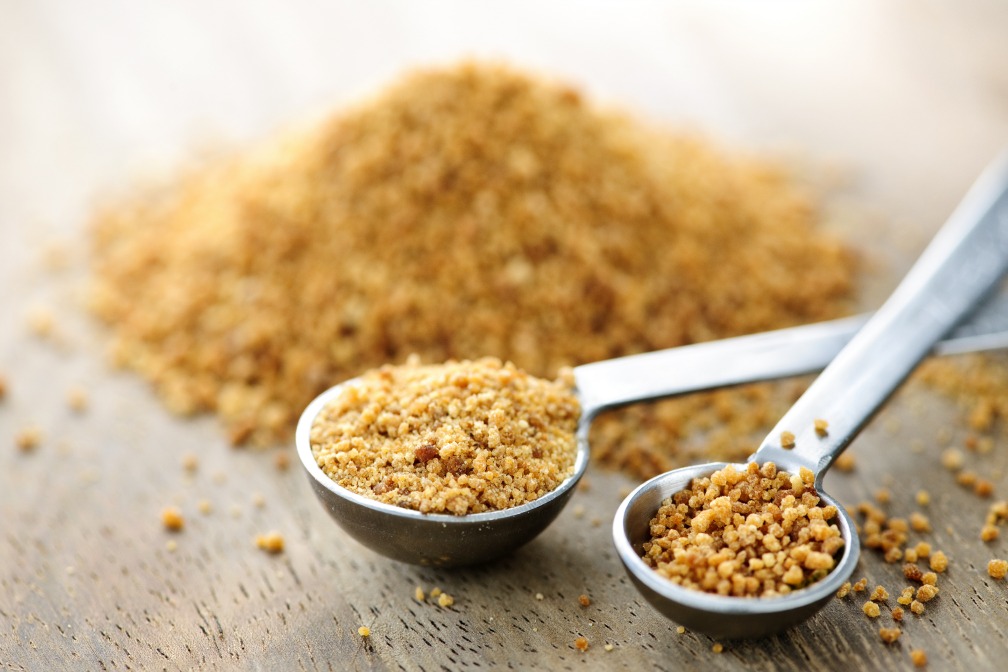 Palm sugar is made from the sap of palm trees, primarily the coconut and arenga trees. Palm sugar has been a staple in India, Indonesia, the Philippines and nearby countries for many years under the name “jaggery.” This sap is frequently harvested from the flowers of the palm trees and then dried by cooking. The traditional form of palm sugar has been chunks of the evaporated jaggery. However, the newer products on the US market include both jaggery that has been ground into small granules, as well as liquid forms (“coconut nectar”). Indonesia and the Philippines are producing palm sugar for the health food market. Palm sugar granules are light brown in color, resembling brown sugar, and have a rich taste similar to brown sugar. If you’re going to purchase palm sugar, it is best to purchase products that include only palm sugar, as some palm sugars are mixed with sucrose. This is acceptable for the countries in which jiggery is traditionally used, however, it could be problematic for someone trying to avoid dietary sucrose.
Palm sugar is made from the sap of palm trees, primarily the coconut and arenga trees. Palm sugar has been a staple in India, Indonesia, the Philippines and nearby countries for many years under the name “jaggery.” This sap is frequently harvested from the flowers of the palm trees and then dried by cooking. The traditional form of palm sugar has been chunks of the evaporated jaggery. However, the newer products on the US market include both jaggery that has been ground into small granules, as well as liquid forms (“coconut nectar”). Indonesia and the Philippines are producing palm sugar for the health food market. Palm sugar granules are light brown in color, resembling brown sugar, and have a rich taste similar to brown sugar. If you’re going to purchase palm sugar, it is best to purchase products that include only palm sugar, as some palm sugars are mixed with sucrose. This is acceptable for the countries in which jiggery is traditionally used, however, it could be problematic for someone trying to avoid dietary sucrose.
Recently it has been reported that at least some palm sugar products have a low glycemic index of 35 (others have been reported to have a glycemic index of 41). However, it does not appear that this has been confirmed by very many laboratories, and there is apparently some variation in the makeup of palm sugar (some products may contain added sucrose). The main simple sugar in this product is sucrose, at 70-79%, while glucose and fructose make up the rest of the sugar content. The reported glycemic index to 35 may be accounted for, in part, by fructose content, but it’s likely that some other carbohydrate, fiber or protein in the product delays absorption of the sucrose, accounting for the low rise in blood sugar (to the extent that this low glycemic index value is, actually, accurate). While the sucrose may not cause an immediate rise in blood sugar, you are still eating sucrose when you eat palm sugar. If you eat it continually, day in and day out, you are likely to see effects of the sucrose eventually, including the non-glycemic effects that many people report, including low mood, yeast infections and other problems. Diabetic patients should definitely consult with their nutritionist or physician before trying palm sugar. Palm sugar does apparently contain a number of healthful minerals such as potassium and magnesium, but should not be regarded as a feasible source for mineral intake since it should be used only in relatively small quantities.
If palm sugar is to be used occasionally, it can simply be substituted for sucrose or brown sugar in conventional recipes. Experimenting with the coconut nectar recipes is also an option, using it as a substitute for other liquid sweeteners. Restraint, however, is definitely in order with this sweetener.

